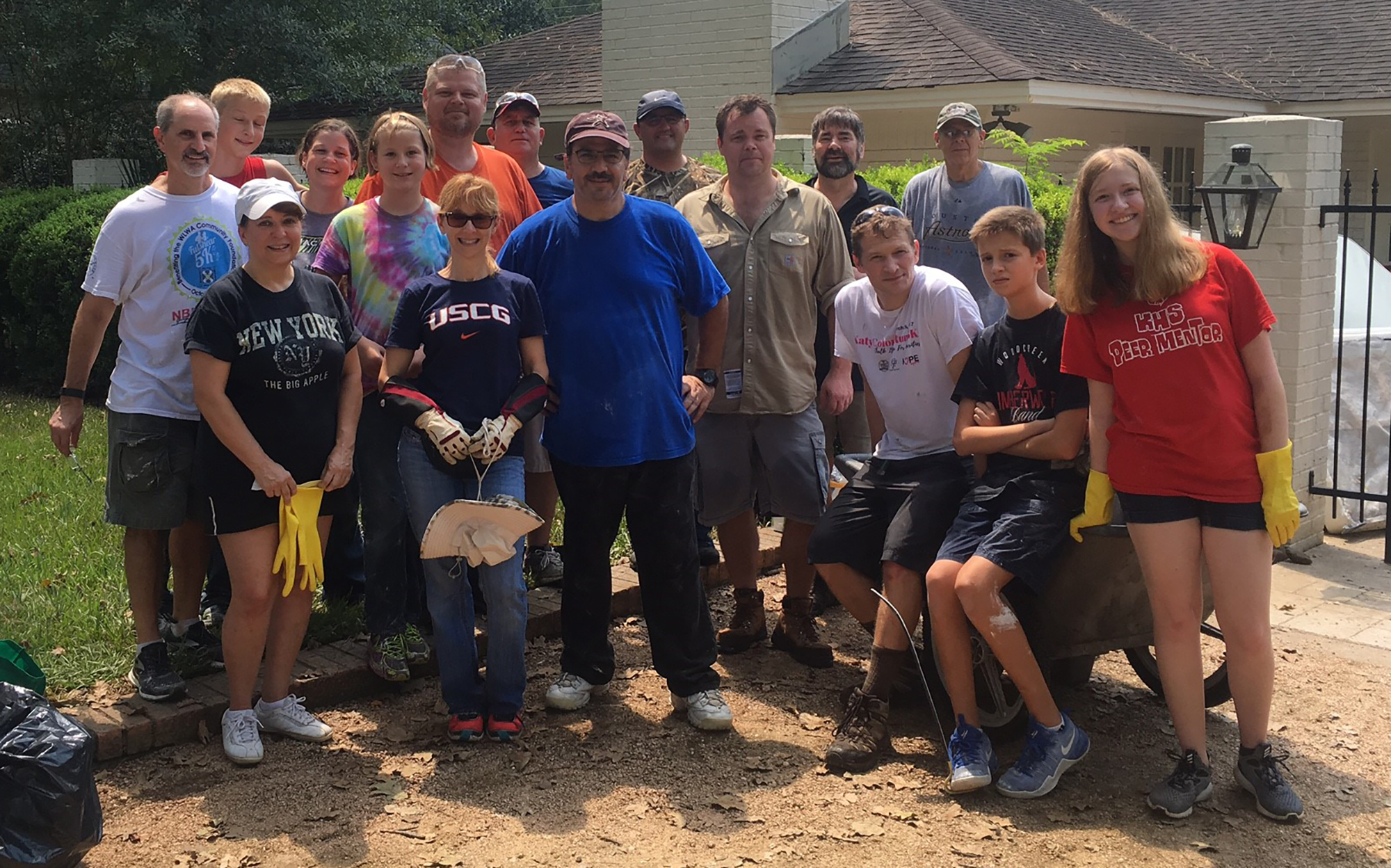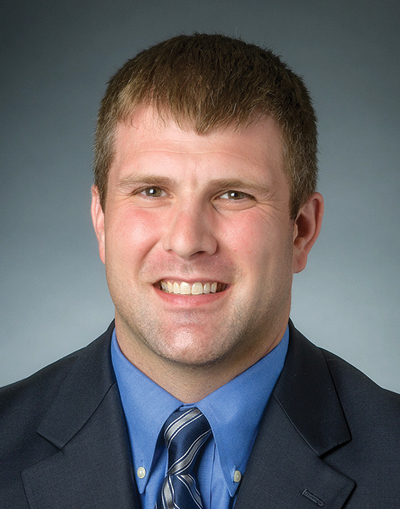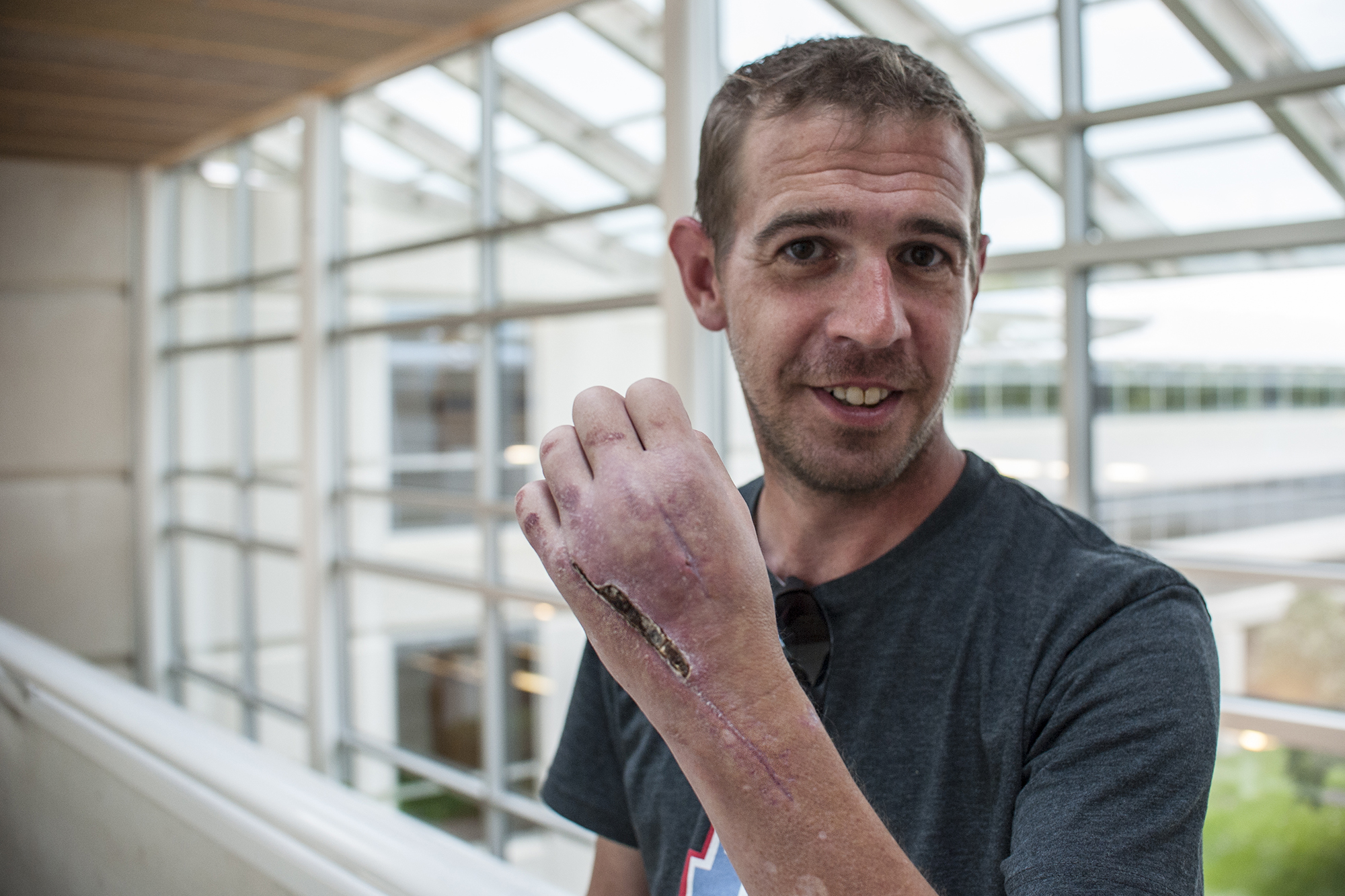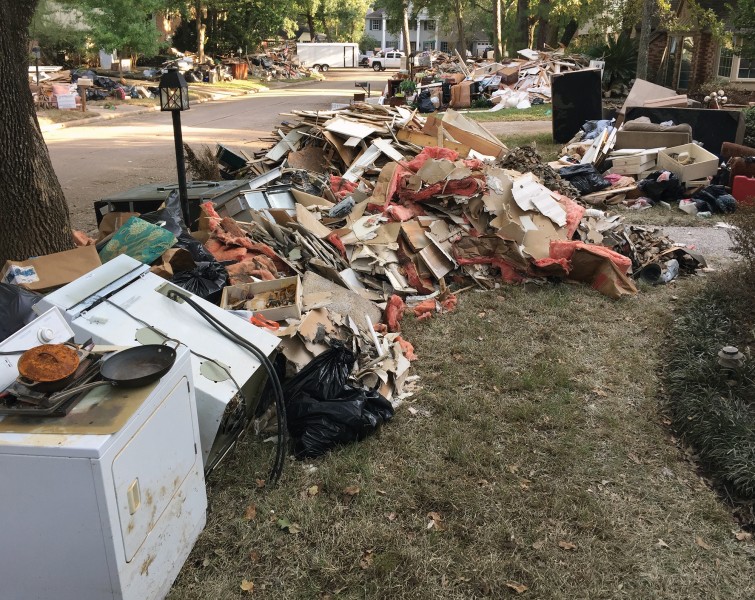
 by Gus Morgan
by Gus Morgan
Houstonians are familiar with flooding. Past storms have scarred this low-lying city: Tropical Storm Allison created a vast lake in 2001; Hurricane Ike roared through in 2008; and let’s not forget the Memorial Day flood in 2015 or the Tax Day flood in 2016, each event inflicting its own wounds.
But the flooding caused by Hurricane Harvey as it evolved into a tropical storm and settled over the Houston area was unprecedented. Some areas received more than 50 inches of rain from the slow-moving storm, putting large swaths of the city underwater and flooding thousands of homes.
The ConocoPhillips workforce was hit hard. The flooding caused nearly 20 percent of local employees to be displaced from their homes. In addition, the floodwaters caused the temporary closure of the company’s main campus and Energy Center 3. While Harvey’s destruction was epic, so was the response by Houstonians and the ConocoPhillips community.

Across the organization, ConocoPhillips workers displayed leadership and collaboration as they helped their flooded colleagues and ensured business continuity.
Human Resources launched an employee hotline so employees could register their storm status and supervisors could get updates on their teams. The Corporate Communications team followed by establishing the Hurricane Harvey Employee Resource Site to provide relevant information and resources. Employees and contractors also received notifications about the event from the Global Alert System.
As the disaster unfolded, the company activated its Disaster Assistance Loan Program and Natural Disaster Cash Assistance Program, providing qualified employees with financial support to help them and their families recover from Harvey’s impacts. The second prong of the response was support for the impacted Houston community.
The following stories offer a glimpse of the activities that unfolded after the historic storm.

Engineer: ‘We got to see humanity at its finest’
Across all levels of the company, ConocoPhillips employees sprang into action to help their colleagues.

Among those was Justin Garner, a drilling and completions coordinator for the Mid-Continent business unit, who anxiously watched as Harvey’s floodwaters crept toward his Memorial-area home.
“I’d never seen water get that high on my street,” Garner said.
His home was spared, but many of his colleagues weren’t so lucky.
TAKING THE INITIATIVE
Eager to help affected coworkers, Garner emailed his work team to see who wanted to help or needed assistance. Next, he forwarded the email to the vice presidents of the Permian and Eagle Ford assets, and they cascaded Garner’s message throughout their organizations.
“I ended up having a list of 100 or so people I would send daily updates to,” Garner said. “I also accumulated a list of people who needed help.”
'THEY INSTANTLY GAVE SUPPORT TO US'
Among the first to respond to Garner’s email was Helene Harding, vice president, Gulf Coast business unit, and Seth Crissman, Garner’s supervisor and manager of drilling and completions for the Gulf Coast and Mid-Continent business units.
“They instantly gave us support,” Garner said. “It was impressive how ConocoPhillips stepped up to assist employees who were impacted and allow those who weren’t impacted to help.”


Also furthering Lower 48 volunteer efforts were Kyle Hampton, a Mid-Continent and Gulf Coast business unit drilling engineer, and Leo Gallegos, Completions Engineering supervisor for the Rockies business unit. Once Gallegos, who had been separately organizing volunteers, learned of Garner’s and Hampton’s efforts, he asked to join their email list.
Garner, Hampton and Gallegos, along with Human Resources General Manager Heather Sirdashney, propelled the coordination efforts. Over 14 days, volunteers provided cleanup assistance at 22 homes.

“We weren’t assigning people, just letting them know of the opportunities,” Gallegos said. “It worked out well. The response from the community as a whole was inspiring. It makes you proud of Houston and Texas. And it was an example of the good that goes on in this world.”
Volunteers proved resilient through harsh conditions. Racing against time and mold, they meticulously rid each home of waterlogged contents. The main goal: allow the houses to dry out. For two weeks, this process repeated itself in the Katy and Memorial areas.
With each house they tackled, volunteers grew more efficient; only the larger, most complex homes required more than a day. During the 14-day cleanup, Hampton said, employees skillfully balanced volunteer activities and work responsibilities.
“We were fortunate that ConocoPhillips was understanding and let us work on this,” said Hampton, who found time to volunteer in between his rig-monitoring duties.


RETIREES, ALUMNI JOIN THE EFFORT
ConocoPhillips retirees also joined the cleanup effort. George Heck, president of the ConocoPhillips Houston Area Retirees Association, shared messages with other retirees and further expanded the volunteer base.
“The devastation was something you hope to never see again,” Garner said, “but we had a glimpse of how good people can be.”
“The ConocoPhillips community is very tight,” said retiree Josh Soybel. “It was really cool to see everyone pull together and help each other out.”
The Harvey Help Team mainly worked on homes of ConocoPhillips employees, Garner said, but they also made time to assist others in need, including a 73-year old widow.
“The devastation was something you hope to never see again,” Garner said, “but we had a glimpse of how good people can be.”
'THE CORE OF WHO WE ARE'
Innovation Manager Dave Mabee said leadership and collaboration were evident across all levels of the organization.
“So many grassroots support efforts sprang up — and these efforts were nurtured and supported by our management,” Mabee said. “We had central coordination from the Yammer site; HSE support for cleanup gear; management support to take the time we needed to help ourselves and others; and visible executive management financial support to both give and match contributions to the Red Cross and United Way.
“Business did go on, but those first two weeks were also about making sure we got the right support to the right people, and I will never forget that.”
TEAMWORK MAKES THE DIFFERENCE
Collaboration played a key role in helping the ConocoPhillips community weather the storm.
“Not everyone could rescue people from flooded homes or do demolition work,” Mabee said. “But collaboration meant that everyone seemed to do what they could. My wife and her friend went to Memorial City Mall every night, collected the first responders’ dirty clothes, laundered them and delivered them back the next morning. Volunteers delivered gloves, safety glasses and dust masks to the work sites, delivered food and drink, and even helped those displaced find places to live.”
The disaster, Mabee said, renewed his sense of community and fueled his SPIRIT Values.
As the initial cleanup work ended, Garner thanked volunteers in an email on Sept. 17.
“I want to give everyone a big thanks for taking time to help your fellow coworkers,” Garner wrote. “This would not have happened if we didn’t have great people wanting to help the community. I have never been so proud to work at ConocoPhillips.”
Employee contracts flesh‑eating bacteria from floodwaters
'YOU CAN'T REFUSE TO HELP PEOPLE JUST BECAUSE OF FEAR'
J.R. Atkins, senior analyst, Automation & Supply Chain Integrated Visibility, remembers the moment his left hand dipped into Harvey’s floodwaters.
He was kayaking down the flooded streets of his neighborhood in Missouri City, Texas, a suburb of Houston, checking on his neighbors in the wake of the storm.

While making a turn, his oar and left hand became submerged in the floodwaters for only a second. But doctors believe that was all it took for Atkins to contract necrotizing fasciitis, also known as flesh-eating bacteria, through a mosquito bite on his wrist.
As a former firefighter and paramedic, Atkins was aware of the threats posed by bacteria in floodwaters. Before he went out that morning, he donned boots and waders and taped them down to protect himself. But he didn’t wear gloves.
That afternoon, Atkins noticed a bump on his left wrist about the size of a nickel, resembling a mosquito bite. By the next morning, the inflammation had spread. He outlined the spot with a marker and went about his day.
Soon the inflammation moved down into his hand. The pain intensified, and heat radiated from the swollen area.
From his medical training, Atkins knew that when an infection or swelling moves across a joint, it’s time to seek immediate medical help. He went to an urgent care clinic.
“I was hot and cold, hot and cold and very lethargic. Then I noticed I couldn’t feel my pinky finger.”
Atkins was running a high fever and was told to get to a hospital immediately. He went straight to the only one in the area not closed due to flooding.
There were about 80 people in line in the emergency room (ER). Atkins was told to wait and found a comfortable spot on the floor. His wife, Cori, put blankets on him.
“We waited in the ER waiting room for six hours,” he said. “By then, I felt like I had the flu. I was hot and cold, hot and cold and very lethargic. Then I noticed I couldn’t feel my pinky finger.”

He approached the triage desk again to plead his case, and the staff took Atkins into the ER. In less than an hour, doctors had a diagnosis: necrotizing fasciitis, the technical term for flesh-eating bacteria.
Atkins was admitted to the hospital and told he would need several surgeries. That night, after his wife had gone home, he was watching a documentary on television.
“All of I sudden I couldn’t hear the film.”
Atkins hit the call button, and a nurse came immediately. His blood pressure had plummeted, and he was going into shock. The infection had moved into his bloodstream, attacking his blood.
He heard someone mention septic shock, which he knew was associated with a high mortality rate.
“I had worked with septic shock before,” he said, “And I didn’t remember a positive outcome.”
Atkins was transferred to the intensive care unit (ICU). As his blood pressure continued to decrease, he remembers thinking, “This is not a good situation to be in.”
Atkins lost consciousness. When he awoke hours later, his blood pressure had stabilized. The worst was over, but he said that night was the scariest.
He was in the hospital for 11 days, five of them in ICU. During that time, he contracted pneumonia and underwent three surgeries to clean and drain the infected area. Although doctors expect him to make a full recovery, it will take months of physical therapy to strengthen his hand, wrist and arm.
The experience has not dampened his passion for helping others.
Geologist: ‘We thought we were off the hook’

Flooding from Hurricane Harvey damaged the homes of many ConocoPhillips employees in Houston, including Nick Fryer, principal geologist in the New Venture Projects group.
On Sunday, Aug. 27, Fryer and his wife, Christine, watched as floodwaters crept toward their front door. Although the water receded that afternoon, it was a close call. Fryer and his wife went to sleep that night thinking their house, located about a mile from Energy Center 3 in west Houston, would escape the floodwaters.
“We thought we were off the hook,” Fryer said. “We thought we had survived the worst.”

But when the U.S. Army Corps of Engineers began releasing water from the Addicks and Barker reservoirs on Monday morning, the water in Fryer’s neighborhood started rising. The Fryers’ home, located near the confluence of the reservoirs’ spillways, was in an unenviable location. In a flash, the situation took a turn for the worse.
Around 7 a.m., water started coming into the house. By 9 a.m., it was over their ankles. The couple scrambled to save their possessions, putting tin cans under their furniture and raising their vehicles several inches.
“We thought we could raise things enough to avoid the flooding,” Fryer said. “It quickly became evident that wasn’t going to cut it.”
The couple managed to get most of their furniture and sentimental possessions upstairs. But when the water reached their electrical outlets, they knew it was time to get out.
“We thought we could raise things enough to avoid the flooding. It quickly became evident that wasn’t going to cut it.”
— Nick Fryer
Earlier, the couple had noticed a man in a red inflatable boat with an outboard motor ferrying people out of their neighborhood. The Fryers flagged him down. A short time later, he ferried the couple to safety, carrying just their passports, vital documents and a change of clothes.
Fryer asked the man whether he was with FEMA or the Red Cross.

The man replied: “No. I live in the Heights. Since I had a boat, I wanted to help. I’m just a volunteer.”
Those words illustrated the massive effort that played out during and after the storm. When the water finally subsided, nearly two weeks later, a crew of ConocoPhillips volunteers, mainly from Fryer’s group, assisted them with the cleanup and demolition work.
Like army ants devouring an elephant carcass, the volunteers stripped the Fryers’ house to its bones, removing Sheetrock and carrying damaged items, furniture and knickknacks onto the front lawn.
“I couldn’t believe it,” Fryer said. “They ripped out the floors and took the walls down to the studs, all in one day. Then they started drying out the house with fans and dehumidifiers.”
Fryer said it was a huge relief to know the company supported him during his time of need, allowing him to focus on recovering from the disaster without worrying about having to return to work right away.
“It was really comforting to know that,” he said. “It’s truly staggering the support that ConocoPhillips has put together for us. Having the company’s support was another positive in this experience, and it has been much appreciated.”
Despite all the destruction and the long recovery ahead, Fryer remains optimistic.
“With disaster there is opportunity,” he said. “We think it will take us about a year to get ourselves back to normal again. We’re going to make some modifications to the downstairs that we’ve talked about in the past. Now that we’re down to the studs, we can consider that. There’s definitely a silver lining to all of this at the end of the day. You have to be positive, otherwise it will be a long year.”
About the author

GUS MORGAN is a writer, photographer and contributing editor for spiritnow. For more than 21 years, Gus has used his communications skills to inform and inspire. He spent 16 of those years in the newspaper industry, working as a reporter, photojournalist and editor. Prior to joining ConocoPhillips in 2014, he served as a communications consultant for Shell Oil Company and BG Group. Gus holds bachelor’s and master’s degrees in journalism.

 by Gus Morgan
by Gus Morgan